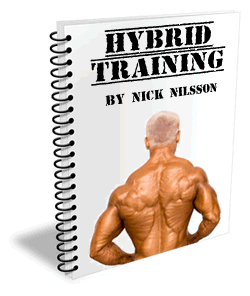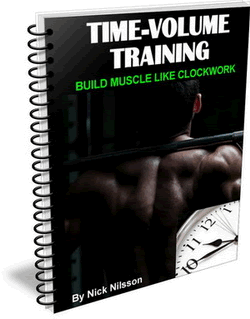Band training is extremely useful for what's called "accommodating resistance."
However, the first thing most people think about when they hear the phrase "band training" are those thin, aerobic-class/rehab bands... basically a long sheet of latex rubber.
It's time for a new perspective on band training that will shatter that thought forever.
Recently, I started reading a LOT about the training techniques of top powerlifters...the guys who squat in the 900 lb+ range, bench 600+, and deadlift 700+. NOT your average lifters, to be sure. But my focus in reading about their techniques was not to try and put up huge numbers like that.
Because believe me, I've got TREMENDOUS respect for the dedication and raw power these men and women possess. I know what kind of training (and eating!) it takes to get to that level.
My purpose in learning their techniques was to be able to apply that information for YOU. Basically, what can the best techniques of the top lifters in the world do for YOUR squat and YOUR bench press?
FYI, this is my recommended source for training bands. (Note: Use Coupon Code "rbtfitstep" to get 10% off your purchase of a band package)
So what IS the single best technique I can pass onto you that will have the biggest impact on your lifting? Band training.
Why is band training so good?
Right now, I want you to picture yourself doing a barbell bench press. You lift the bar off the racks, lower it to your chest, then press it back up to the top. It's a movement you've done plenty of times.
But here's the kicker...when you train with just a barbell, the amount of weight you can lift for the entire exercise depends completely on how much weight you can lift at the WEAKEST POINT in the range of motion.
With "normal" weight training and a full range of motion, your ultimate strength levels (and muscular development) are based solely on how much you can lift at your weakest, NOT your strongest points in your lifts.
It means you're NOT training to your muscle's full potential.
One of the major benefits of band training is that it fixes that strength curve problem instantly and VERY effectively.
When you add bands to the mix, you immediately change the strength curve of the exercise.
If you're not familiar with the term, a strength curve is basically a gauge of how much resistance a muscle is able to move at a given point in an exercises range of motion.
For example, when doing the bench press, your muscles have better leverage near the top (making you able to move more weight near the the top) and worse leverage near the bottom (making you able to move less weight near the bottom). The graph of this change in leverage is known as a strength curve and it can be charted for any exercise.
In practical terms, adding bands to an exercise means that you're no longer limited by how much weight you can lift at the weakest point in the range of motion.
Back to the bench press example. Imagine the bench press being set up in the power rack instead of on a bench press station. Now imagine two bands attached to the top cross-beams of the rack...the other ends of the bands are looped around the barbell.
You lay down on the bench and unrack the bar. As you start to lower the barbell to your chest, the bands start to stretch, taking up some of the weight of the bar, in effect reducing the resistance.

The lower you bring the bar, the more the bands stretch and the more help the bands give you. When you get to the bottom of the press and start to push back up, the elastic energy of the bands helps you to get that bar past the sticking point (the weakest point in the range of motion).

Now here's the benefit...once you're past that sticking point, the bands lose their stretch and gradually help you less and less, mimicking the strength curve of the bench press almost exactly.
They help more at the bottom and less at the top.
So when you use bands in this manner, you can load the bar with MUCH MORE weight than you could normally use for a regular bench press. For example, if you bench 225 lbs for 5 reps, you could use (depending on the thickness of the bands) about 315 lbs for 5 reps.
NOW your muscles are getting maximum overload through the ENTIRE range of motion. You're lifting as much as your muscles can handle at the weakest point in the range of motion AND as much as your muscles can handle at the STRONGEST point in the range of motion, all in a dynamic fashion.
Bands are also useful developing power and explosiveness.
Say you're interested in developing power and explosiveness in your legs for a particular sport. Or you just want to increase your strength out of the bottom of the squat.
Now, instead of anchoring the bands ABOVE you in the rack, you're going to anchor the bands BELOW you. Instead of having the bands dynamically HELP you, they're going to dynamically work AGAINST you, leading to great gains in power and acceleration out of the bottom. Here's how it works...
First, you set up the squat as you normally would in the power rack. But there are two differences...first, you'll need to use LESS weight than you normally would for a squat because you're going to be adding bands for resistance. Second, you're going to start out of the BOTTOM instead of the top (it's MUCH easier to do it this way than to try and step back with the barbell on your back and the bands trying to pull you down).
When I do this exercise, I use two heavy dumbbells to anchor the bands onto down on the floor (one on either side). Some racks actually have pins specifically FOR band training but it's not common. Heavy dumbbells work just fine. Attach the bands to the dumbbells then you'll loop the bands over the ends of the barbell.
Now get under the bar and into the bottom position of the squat.

When you're set, explode powerfully up to the top position of the squat.

You'll notice as you power up, you're working against ever-increasing tension from the bands stretching out! So explode all the way to the top...the bands will keep you in check.
Why is this technique so effective?
Because when you're training normally, the last part of the range of motion of an exercise is used by the body to actually decelerate the weight (i.e. slow it down). This is a natural reaction that is designed to prevent injury. If the weight is still moving at the end, the joints are going to take the brunt of it and possibly get injured.
But this deceleration at the end of the movement also robs you of your explosiveness. By using bands as resistance, the bands work as brakes to slow the weight down for you. You can accelerate strongly all the way to the end of the exercise without the body trying to slow you down.
In essence, you're teaching your body how to explode up! The muscles and nervous system learn this acceleration and it carries over directly to your "normal" training. This means you'll be able to power out of the bottom of the squat with heavier weight. Not a bad deal!
There are a few downsides to band training.
The first is if you're allergic to latex. Most, if not all, training bands are made of latex so if you have an allergy, you'll need to wear full gloves to handle the bands or get somebody else to set up the exercises for you.
The second is that if you work out in a commercial gym, you'll have to carry your bag of bands to the gym with you. Luckily, being as rubbery as they are, they'll pack easily into a duffel bag so that shouldn't be a big problem.
Third is setup. Before you use the bands in an actual workout, you'll want to take some time to familiarize yourself with attaching the bands to the power rack and figuring out how to best set up the equipment to do the exercises with the bands.
It's well worth the effort, though, because band training is TREMENDOUSLY effective for increasing strength.
RBT BANDS
So now that you know what band training can do for you and how to use bands in your training, it's time to tell you what sets RBT bands apart from other companies and why I recommend them.
First and foremost is QUALITY. These are NOT cheap bands that will snap with hard use. Because let me tell you, I show my bands NO MERCY and they have showed NO signs of wear. These bands will take whatever you can dish out and I'm speaking from experience.
Second is price. RBT bands are VERY reasonably priced, especially when you consider the quality of bands you're getting. They also offer different sized bands in package deals, which makes it even better. I haven't found a better combination of price and quality anywhere.
Third is selection. RBT has bands for every spectrum of training, from light rehab bands all the way to the thicker bands that you would use for heavy squatting and deadlifting. You'll find bands to fit any need here.
Note: Use Coupon Code "rbtfitstep" to get 10% off your purchase of a band package.
Hybrid Training
In "Hybrid Training," you'll learn how to combine multiple resistances (like bands, free weights and cables), to overcome problems in strength curves (as I explained above).
"Hybrid Training" guides you through a multitude of exercises for every single bodypart, showing you how to set them up and perform them for maximum effect. I use bands in many of the exercises, including the two that I mentioned above (Reverse Band Bench Press and Band Squats) as well as many others that use bands to alter not only how much resistance you get but the DIRECTION the resistance is coming from.
This is great stuff that has the potential to skyrocket your strength and your muscle mass.
![]()
More From Fitstep.com
| The 7 Biggest Training Mistakes I've Ever Made | |
| Why I Hate Supplements | |
| The Great Big List of Calorie-Free Foods | |
| The CURE For Stubborn Quads |
Share This Page...
---
Home -> Muscle and Strength -> Training Equipment Reviews -> Bands




